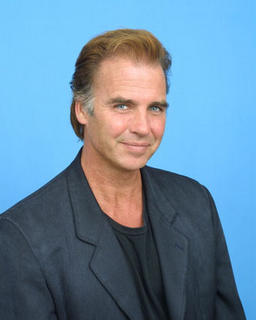Jeff Fahey as cultural icon (originally published on Mondo Irlando, 7th October 2005)
 Introduction
IntroductionJeff Fahey was born Jeff Fahey in 1952. The true events of his conception are mostly unknown, although academics have argued about it for almost half a century. Stories abound concerning mighty chariots in the sky, badgers the size of elephants roaming back alleys in search of their next junk fix, and a large Man Ray-esque porcelain woman carrying a pitchfork. These anecdotes are as yet unproved, and may well have historical roots in Chagatai
His mysterious origins cast Fahey into the shadows of
On his tenth birthday the Fahey family moved to
Fahey graduated high school and decided to make an attempt to join the bohemian lifestyle. First he hitchhiked to
Dysphoric and tired, Fahey left for
It was during this time that Fahey combined Sartre’s teaching with broader metaphysical dialectics resulting in what would later be known as Fahey doctrine (also called Faheyian discourse, mainly by a group of rogue Italian Futurists who later on framed it around a post-structuralist adumbration, thus creating, obviously, post-Faheyian discourse). Fahey also produced a number of critical essays on Russian literature, specialising on Pushkin.
Following a hostile parting with Sartre over a dispute on the ethics of washing machines, Fahey had a passionate love affair with Allen Ginsberg. Living in
Ginsberg introduced Fahey to the cinema of Godard and Truffaut at this time sparking an everlasting love affair with film. Fahey decided he needed to interpolate himself into the new wave scene and so went down to one of the major studios where he was met at the door by a burly, bearded giant of a man who said, “The French new wave ended a decade ago...cunt.”
With no prospects, a sudden and unexpected exit of Ginsberg, and a rising sense of fear and paranoia, Fahey decided to return to the
He had for a long time suspected that the shadowy presence he had felt was more than just simple psychosis, but it was not elucidated until that fateful plane journey back home. Upon entering the plane, as passenger witnesses later recounted, Fahey got to his seat only to find another sitting there. It was none other that Fahey’s evil doppelganger, Fayhey!
A struggle ensued and luckily Fayhey was ousted from the plane by a stewardess. But Fahey was shaken and knew simple pride damage would do nothing to prevent Fayhey one day coming for him.
Once back in the US Fahey began a hugely successful career in the motion arts, putting his European intellectual adventures behind him forever.
Hypothesis: Jeff Fahey is the most important cultural icon of the 20th century.
When the start titles to Sketch Artist (1992) finish and we are witness to the hero protagonist of the story, Jack Whitfield, played by a certain Jeff Fahey, a number of signifiers are presented to the audience. Those blue eyes shine through all other symbols existent on screen, a juggernaut of semiotics emerges. A certain angelic harmony is the denotative aspect; those eyes say this is a man of supreme virtue. These signified denotations are most evident in films such as The Last Of The Finest aka Blue Heat aka Street Legal (1990), and Johnny 2.0 (1998), where Fahey played the unforgettable character of Johnny Dalton.
With this first layer of optical (if we can even regress it to such frivolousness) analysis scraped sufficiently, we now enter a deeper sense of what constitutes the true nature and affect of those globular masteries.
Associations of archetypal quintessence are connotatively communicated most overtly in the character of Dale Goddard (no doubt a reference to his former interests in the French new wave) in The Sweeper (1996). It, and probably Epicenter (2000), present certain deep resonances that not only act as a representation of modern cultural identity, but also play the major part in creating zeitgeists of contemporary thinking.
The symbol of Jobe’s hair in The Lawnmower Man (1992) is undoubtedly one of the most imposing signs occupying Fahey’s filmography. The inherent meaning in this symbol is understood by any individual with societal knowledge of any kind, and this is the primary reason behind car manufacturer General Motors’ recent decision to transform all headrests into model replicas of Jobe’s hair.
It’s these types of affects where we see Fahey transcending beyond his humble core into general ideology. The character of The Dutchman in Small Time aka Waiting For The Man (1996) may have been a small part but it has come to summarise all of our thinking on the subject of how media imagery interacts with mass society.
In conclusion, Jeff Fahey virtually constructed the philosophy of textual analysis and his films formed a framework for that of which no other filmic personality has ever even conceptualised mentally. With films such as Scorpius Gigantus (2005) on the release horizon, this chieftain of cerebration does not look like slowing down anytime soon.


2 Comments:
Brilliant.
For some strange reason, I suspect Fahey would enjoy this immensely (if he didn't write it himself under a pseudonymn).
You have talent, perhaps of a Fahey-type iconic nature, but who can tell, really, since we can't see your orbs.
Cheers.
Quite impressive. Do you know Jeff Fahey personally? Anyway, it was very interesting to read. Jeff Fahey must be a very intellectual man. Maybe too intellectual for Hollywood.
Post a Comment
<< Home